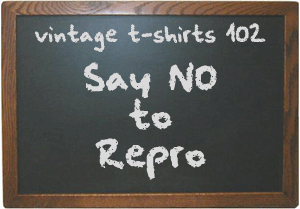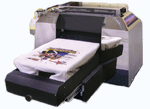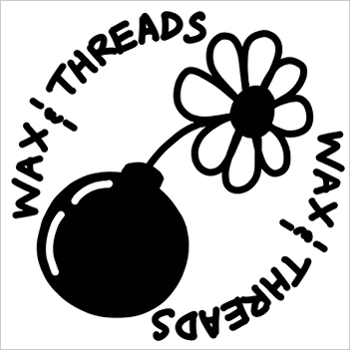Other guides:
Vintage T-Shirts 101: eBay Shopping Guide.
Vintage T-Shirts 103: The Brand Gallery.
Vintage T-Shirts 104: Identify Fakes.

Making sure your item is genuine is tricky sometimes, since listings can be misleading. The recent surge of counterfeit vintage shirts online breaks our hearts. Some of these operations sell very convincing fakes (we’re actually amazed) mixed amongst genuine pieces. Others print new designs on plain vintage shirts. Many of these dealers buy repros in bulk – so you’ll notice multiple sellers carrying many of the exact same prints. With all these creative and sneaky techniques, it’s become even trickier to get the real deal.
One easy solution, however, is to buy from Defunkd vendors. Because we pre-screen our vendors and only allow experienced sellers with an honest track record – you’re guaranteed to get the true vintage t-shirt you desire. But we know the auction format can be tempting so just be aware there are certain red-flags to watch out for. Often, the listings will not display the tag – it will be removed, or look like an uncommon, yet vintage-esque brand, ie. “Mahagamage.” It’s gotten so out-of-hand that designs originally printed on only one colour of shirt are starting to appear in an array of other colours. If Bill and Ted were to chime-in now, you can bet they’d say, “Bogus!”
If the written details and photos in the listing are scarce and non-descriptive, do your research. Keep in mind some listings misuse “vintage” as a keyword to generate exposure for other items. Look for sharp close-ups of copyright printing and date subscripts. Consider the actual look of the printing, as many reproductions use just one color. Also inspect the quality of the printing – watch for inaccurately sized, wrongly placed, poorly coloured or pixelized prints.
 If you understand the screen printing process you’ll spot the knock-offs more easily. Screen-printed items are made in stages, with each colour printed separately. So when a shirt has a 5-colour design, it’s passed under 5 different screens to add the appropriate colour to the specific locations on the fabric. Think of it like a jig-saw puzzle, where each colour is a separate piece, and when put together, makes up the total design.
If you understand the screen printing process you’ll spot the knock-offs more easily. Screen-printed items are made in stages, with each colour printed separately. So when a shirt has a 5-colour design, it’s passed under 5 different screens to add the appropriate colour to the specific locations on the fabric. Think of it like a jig-saw puzzle, where each colour is a separate piece, and when put together, makes up the total design.
What does this analogy tell us about identifying fakes? First off, most counterfeiters don’t have the original image to work with, so they scan a copy of it. The integrity of the design is compromised because colours and fine lines aren’t matched properly. Sometimes entire colours or details are omitted if it’s too difficult to pick up or used very little in the original design.

Given these indications of forgery, the example above shows a comparison between an authentic design and a forgery, with close-ups of their subscripts. Notice the differences in color, detail and copyrights. When compared side by side, it’s obvious which is which. On their own, though, it’s less apparent which is the repro. Make sure to do comparative shopping.
 One of the lastest trends in vintage tee counterfeiting exploits a new, quick t-shirt printing technology. I stumbled upon this method when I was given the duty of printing a few t-shirts that had to be ready for a bachelor party, asap. Many print shops now use industrial-level printers that can turn a low quality image in to a semi-convincing article, especially if printed on an actual vintage t-shirt. And better yet for the counterfeiters, these machines are designed to print one shirt at a time. This means they don’t have to commit to minimum orders; and once the shirt is printed there is no evidence left over (negatives, screens, ink). There’s a few eBay vendors continually churning out bogus products in this manner for a quick profit. Then once their account has received a significant amount of negative feedback they start a new eBay ID. I stress again, always thoroughly check a seller’s negative feedback prior to engaging in a transaction.
One of the lastest trends in vintage tee counterfeiting exploits a new, quick t-shirt printing technology. I stumbled upon this method when I was given the duty of printing a few t-shirts that had to be ready for a bachelor party, asap. Many print shops now use industrial-level printers that can turn a low quality image in to a semi-convincing article, especially if printed on an actual vintage t-shirt. And better yet for the counterfeiters, these machines are designed to print one shirt at a time. This means they don’t have to commit to minimum orders; and once the shirt is printed there is no evidence left over (negatives, screens, ink). There’s a few eBay vendors continually churning out bogus products in this manner for a quick profit. Then once their account has received a significant amount of negative feedback they start a new eBay ID. I stress again, always thoroughly check a seller’s negative feedback prior to engaging in a transaction.
 Factor in the shirt’s material. A lot of vintage shirts are made of a 50/50 poly-cotton blend, while the 100% cotton blends are a more recent trend. And get to know your vintage shirt brands by the tags. This labeling is a great indicator because many of these companies are no longer in production. Names like Screen Stars, Springford, Sportswear, Touch of Gold and Ched are good examples of genuine tag names. Hanes, while still in production, has seen different phases of labels over time which can easily be identified with a particular era. To get a better idea of these brands, please review our third guide which is a resource of vintage brand images.
Factor in the shirt’s material. A lot of vintage shirts are made of a 50/50 poly-cotton blend, while the 100% cotton blends are a more recent trend. And get to know your vintage shirt brands by the tags. This labeling is a great indicator because many of these companies are no longer in production. Names like Screen Stars, Springford, Sportswear, Touch of Gold and Ched are good examples of genuine tag names. Hanes, while still in production, has seen different phases of labels over time which can easily be identified with a particular era. To get a better idea of these brands, please review our third guide which is a resource of vintage brand images.
- Always check Defunkd’s shops for less expensive inventory found elsewhere.


![[ LINK IN BIO ] In honor of May the 4th we connected with a gentleman named Shawn whose father, Ira, worked for ILM. He designed the Biker Scout, need we say more? Shawn shared an epic tale of a bootleg Star Wars tee his dad heroically stashed away despite George Lucas' attempt to have it destroyed.
.
RIP Ira Keeler. Long live the resistance.
.
#vintagetshirt #vintagetee #vintagetees #vintagetshirts #maythe4th #maytheforth #starwarsday #georgelucas #starwarscollectibles #starwarscollectible #ILM #starwarscollection #starwarscollector #starwarscollectors #starwars #starwarsfan
#irakeeler](https://www.defunkd.com/newblog/wp-content/plugins/instagram-feed/img/placeholder.png)
